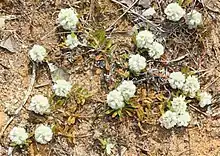| Ptilotus humilis | |
|---|---|
 | |
 | |
| Scientific classification | |
| Kingdom: | Plantae |
| Clade: | Tracheophytes |
| Clade: | Angiosperms |
| Clade: | Eudicots |
| Order: | Caryophyllales |
| Family: | Amaranthaceae |
| Genus: | Ptilotus |
| Species: | P. humilis |
| Binomial name | |
| Ptilotus humilis | |
| Synonyms[3] | |
|
Trichinium humile Nees | |
Ptilotus humilis is an annual herb[4] in the Amaranthaceae family,[1] native to Western Australia.[3] It was first described as Trichinium humile by Nees von Esenbeck in 1845[1][5] but was transferred to the genus, Ptilotus, by Ferdinand von Mueller in 1868.[1][2]
References
- 1 2 3 4 "Ptilotus humilis". Australian Plant Name Index, IBIS database. Centre for Plant Biodiversity Research, Australian Government.
- 1 2 von Mueller, F.J.H. (1868). "Amarantaceae". Fragmenta phytographiae Australiae (in Latin). 6: 229. Wikidata Q106317902.
- 1 2 "Ptilotus humilis (Nees) F.Muell. | Plants of the World Online | Kew Science". Plants of the World Online. Retrieved 1 April 2021.
- ↑ "Ptilotus humilis". FloraBase. Western Australian Government Department of Biodiversity, Conservation and Attractions.
- ↑ Nees von Esenbeck, C.G.D. (1845). Lehmann, J.G.C. (ed.). "Amarantaceae". Plantae Preissianae (in Latin). 1: 628. Wikidata Q106317642.
This article is issued from Wikipedia. The text is licensed under Creative Commons - Attribution - Sharealike. Additional terms may apply for the media files.